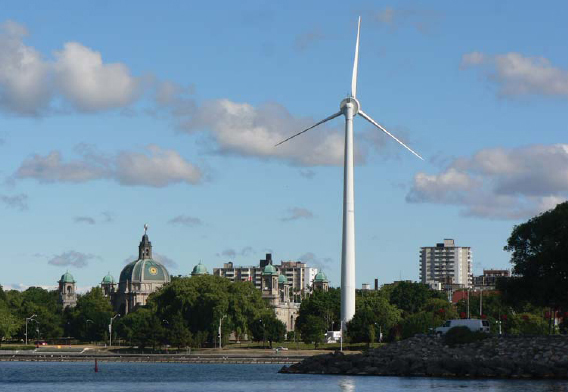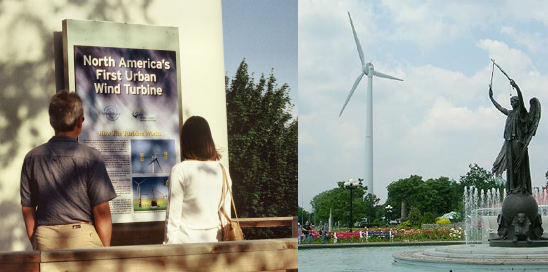Toronto, Ontario
ExPlace (Canadian National Exhibition), Lake Ontario
(1) 750 kW turbine (equivalent to 250 homes)
Development Timeline: 1998 - 2002
Owners: WindShare Cooperative and Toronto Hydro Energy Services (City of Toronto) each have 50% ownership.

Project History:
The North Toronto Green Community citizen's group initiated the Toronto Renewable Energy Cooperative (TREC) in 1999.(1) To determine local interest and support, TREC began a community outreach program and held public information meetings in community centers, church halls and institutions across the Greater Toronto Area. In 2002, TREC joined with Toronto Hydro Energy Services to develop the project and formed the WindShare Cooperative to co-own and co-manage the project.(2)
Site:
In 1999, TREC received a grant to study three potential sites for an urban wind turbine project in Toronto, and almost 3 years of community consultations and wind testing were conducted before the site was selected.(3) The site selection process initially favored other sites, and in fact 11 lakefront sites were considered including a sewage treatment plant, a water filtration plant, and a public park. Information about the process can be found on the WindShare website, including efforts to involve environmental and ornithological (bird) groups in the process. An extensive community involvement process settled upon a promising site, but “opposition from a nearby yacht club and questions about who owns the land beneath the original site at the city's sewer treatment plant forced TREC to cast about for alternative locations. ExPlace came to the rescue.”(3)
The site is a highly visible location at the Canadian National Exhibition (Exhibition Place) on the shores of Lake Ontario. “The turbine can be seen from all approaches to the west, including Toronto's international airport. Joggers, strollers, and picnickers all share the space with the turbine.”(3)
Ownership:
According to WindShare Director Ed Hale, initial supporters were inspired by the experience of Denmark: “The co-operative model is inherently democratic. Each member gets one vote regardless of the number of shares they own. It prevents any single entity from taking over the direction. It is also easier to raise funds publicly than in a conventional business model, where going through the securities commission is very time consuming and extremely expensive. Also, we wanted this project to be owned by the community and stay with the people of Toronto.”(4)
Half of the project is owned by Toronto Hydro Energy Services, while the other half is owned cooperatively by the cooperative members. Within four months of opening membership, 427 pioneer members had invested an average amount of $2000 each ($500 minumum) in the project. By the second day the turbine was under construction, WindShare membership was fully subscribed and the $800,000 capital investment target had been reached.(2)
The energy from the turbine goes into the Ontario energy grid. “WindShare sells its share of the electricity produced and members receive a dividend based on net proceeds. On February 1st, 2005, WindShare was able to disperse its first dividend to its co-op members.”(5) Each member has one vote, and members vote on major decisions of the cooperative. The coop holds an annual summer picnic beneath the wind turbine and its annual general membership meeting early in the year.(3)
The cooperative model introduced a variety of challenges, including obtaining provincial and municipal governmental permission to build the turbines, the complexity of creating an energy cooperative, conducting environmental assessments, and negotiations with Toronto Hydro.(1)
Current Situation
WindShare and Toronto Hydro continue to discuss future plans for wind turbines in Toronto.(6) Meanwhile, outside of the city WindShare is planning North America’s first community-owned wind farm. Teaming up with the Milverton-based Countryside Energy Co-operative, WindShare is developing the Lakewind Power Project in Bervie, Ontario, at Lake Huron. Lakewind’s five turbines will produce enough power for 3,400 homes.(7)

Photo credits: postcarbon.org (top), www.wind-works.org (bottom left), www.ens-newswire.com (bottom right)
Sources:
2) WindShare Cooperative <www.windshare.ca>
3) Wind-Works by Paul Gipe <www.wind-works.org/articles/TorontosWindShareCoop.html>
5) <www.thenergyservices.com/of_interest/community/index.cfm>
6) Email correspondence with Rose Kudlac, WindShare board, December 2007
7) <www.obviously.ca/enews/article/exhibition_place_wind_power_3_of_3>
9) Gipe, Paul. Renewables Without Limits: Moving Ontario to Advanced Renewable Tariffs by Updating Ontario’s Groundbreaking Standard Offer Program. Toronto: Ontario Sustainable Energy Association, 2007. Dowloaded 12/4/07 from <http://ontario-sea.org/policy.php>
|
